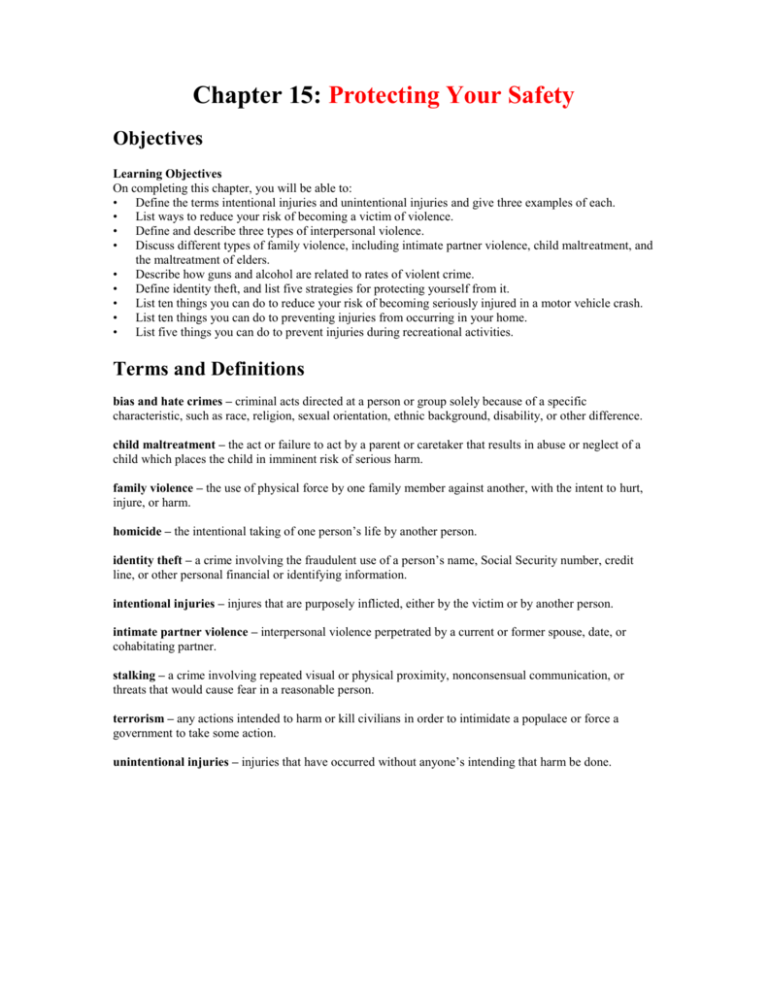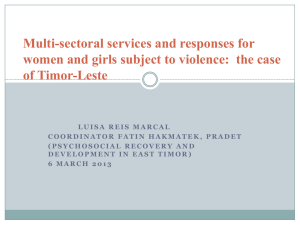Community Activities
advertisement

Chapter 15: Protecting Your Safety Objectives Learning Objectives On completing this chapter, you will be able to: • Define the terms intentional injuries and unintentional injuries and give three examples of each. • List ways to reduce your risk of becoming a victim of violence. • Define and describe three types of interpersonal violence. • Discuss different types of family violence, including intimate partner violence, child maltreatment, and the maltreatment of elders. • Describe how guns and alcohol are related to rates of violent crime. • Define identity theft, and list five strategies for protecting yourself from it. • List ten things you can do to reduce your risk of becoming seriously injured in a motor vehicle crash. • List ten things you can do to preventing injuries from occurring in your home. • List five things you can do to prevent injuries during recreational activities. Terms and Definitions bias and hate crimes – criminal acts directed at a person or group solely because of a specific characteristic, such as race, religion, sexual orientation, ethnic background, disability, or other difference. child maltreatment – the act or failure to act by a parent or caretaker that results in abuse or neglect of a child which places the child in imminent risk of serious harm. family violence – the use of physical force by one family member against another, with the intent to hurt, injure, or harm. homicide – the intentional taking of one person’s life by another person. identity theft – a crime involving the fraudulent use of a person’s name, Social Security number, credit line, or other personal financial or identifying information. intentional injuries – injures that are purposely inflicted, either by the victim or by another person. intimate partner violence – interpersonal violence perpetrated by a current or former spouse, date, or cohabitating partner. stalking – a crime involving repeated visual or physical proximity, nonconsensual communication, or threats that would cause fear in a reasonable person. terrorism – any actions intended to harm or kill civilians in order to intimidate a populace or force a government to take some action. unintentional injuries – injuries that have occurred without anyone’s intending that harm be done. Lecture Outline I. Intentional and Unintentional Injuries In 2007 in the U.S. there were 34.3 million injuries and poisonings that individuals sought or received medical care for. II. Intentional Injuries Each year, intentional injuries cause about 50,000 deaths and about 2 million nonfatal injuries in the United States. A. Interpersonal Violence 1. Homicide The United States leads the industrialized world in homicide rates, with a recent murder rate of 5.6 per 100,000 inhabitants. 2. Other Types of Interpersonal Violence These include robberies, rapes, sexual assaults, and assaults. B. Stalking 1. Nearly all states have tightened their laws prohibiting stalking. Rape and Other Sexual Assault Rape is considered a violent act that happens to be carried out through sexual contact. 2. Sexual Harassment Unwanted attention of a sexual nature that creates embarrassment or stress. C. Bias and Hate Crimes State and federal laws have been enacted to make bias and hate crimes serious offenses. D. Family Violence Families are much more complex and are under more stress than ever. 1. Intimate Partner Violence 2. This crime is vastly underreported to law enforcement authorities. Maltreatment of Children 3. About 1 million children are victims of abuse and neglect each year. Maltreatment of Elders Between 1 and 2 million older adults are victims of abuse and neglect. 4. Violence in our Communities 5. School Violence 6. School violence includes theft, violent incidents, and bullying. Violence at College Traditional aged college students experience less violence than nonstudents in the same age group. 7. Campus Safety and Violence Prevention Interested students can contact Security on Campus which focuses on campus crime. 8. Youth and Gang Violence Gang-related crime has declined somewhat, probably because of more aggressive police tactics. E. Factors that Contribute to Intentional Injuries 1. Alcohol, other psychoactive drugs, and the availability of firearms all contribute to incidence of intentional injuries. F. Identity Theft Order copies of your credit report each year to make sure there are no fraudulent accounts in your name. G. Terrorism An act intended to cause death or serious bodily harm to civilians or noncombatants with the purpose of initiating a population or compelling a government or an international organization to do or abstain for doing any act. III. Unintentional Injuries Unintentional injuries account for more than two-thirds of all injury deaths annually in the U.S. A. Motor Vehicle Injuries and Safety Motor vehicle accidents cause nearly 2.5 million disabling injuries each year. 1. Road Rage Occurs when a driver becomes enraged at the driving behavior of others. B. Residential Injuries and Home Safety 1. Poisonings 2. Leading cause of unintentional injury death in homes. Other Unintentional Residential Injuries The second leading cause of home injuries is falls. C. Injury Prevention at Home D. 1 person in 10 is injured each year at home. 1. For Everyone 2. For Children 3. For the Elderly Recreational Injuries and Safety Basketball and bicycling injuries make up the majority of recreational injuries. Supplemental Resources: Activities, Assignments, and Discussion Material For your convenience listed below are some of the available supplemental assets for this chapter. For the most up-to-date supplement information, please refer to the textbook website Online Learning Center Personal Assessments How Well do You Protect your Safety? * Violence Knowledge Pretest What Are You Doing? *also found in the text Web Activities Fireworks Safety Quiz Safe Cycling Quiz Consumer Product Safety Commission National Safety Council Focus On Drowsy Driving Activities Core Textbook Activities: Talking Points 1. You suspect that someone is stalking you, but your friends think you’re being dramatic. How would you get objective advice on what to do? (p. 389) 2. A close friend confides that her boyfriend sometimes “gets rough” with her. She’s afraid to talk to him about it because she thinks that will make things worse. What immediate steps would you tell her to take? (p. 393) Individual Activities 1. Interview a counselor in an agency that deals with domestic violence. 2. Interview a social worker who works with children who have been abused. 3. List the ways you can address the violence in your community. What groups or organizations can help you in your endeavor? Community Activities 1. Visit a rape crisis center and learn the procedure for helping a rape victim cope. 2. Attend an open hearing on violence in your community (e.g., town council meetings, PTA meeting). 3. Visit your local police department and talk with a detective or officer who handles cases pertaining to domestic violence against all age groups.







